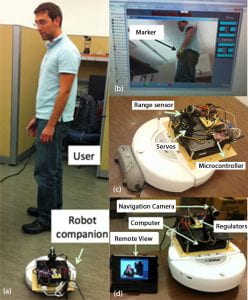Researchers: Luke Buschmann, Sri Kurniawan. In collaboration with Cabrillo College’s Stroke and Disability Learning Center.
Stroke can leave survivors with some form of hemiparesis (weakness of one side of the body). Virtual rehabilitation in the past decade has shown higher success than traditional rehabilitation. It improves the patient’s experience and can allow for clinical rehab without a clinician present. Research in non-virtual rehabilitation shows that constraint induced movement therapy is very effective in treating hemiplegia. In this therapy, the patient’s strong side is physically constrained using a mitt or hand splint on the non-affected limb, forcing the patient to utilize their weaker limb for daily activity.
Read more
 This LASSIE robot is designed to be a monitoring assistive living robot, which is low cost and can be steered over the Internet by family member to remotely monitor and help assess the well-being of an older relative living alone. A commercially available iRobot Create platform was used as a starting point for the Assistive Living Robot, however the system could potentially be used on another robotic base. Our system (i) takes advantage of commercially available systems to reduce development cost and effort, (ii) acts as a video and audio communication tool between older persons and their family members or caregivers and (iii) can analyze the video feed to detect heart rate and breathing rate. The proposed system could be integrated with in-home monitoring sensors (Smart Grid, Professor Patrick Mantey), which could be the trigger for alerting family members that an out of ordinary event is occurring, therefore, our robot could be woken up and sent to be used as over the Internet watchful eye.
This LASSIE robot is designed to be a monitoring assistive living robot, which is low cost and can be steered over the Internet by family member to remotely monitor and help assess the well-being of an older relative living alone. A commercially available iRobot Create platform was used as a starting point for the Assistive Living Robot, however the system could potentially be used on another robotic base. Our system (i) takes advantage of commercially available systems to reduce development cost and effort, (ii) acts as a video and audio communication tool between older persons and their family members or caregivers and (iii) can analyze the video feed to detect heart rate and breathing rate. The proposed system could be integrated with in-home monitoring sensors (Smart Grid, Professor Patrick Mantey), which could be the trigger for alerting family members that an out of ordinary event is occurring, therefore, our robot could be woken up and sent to be used as over the Internet watchful eye.